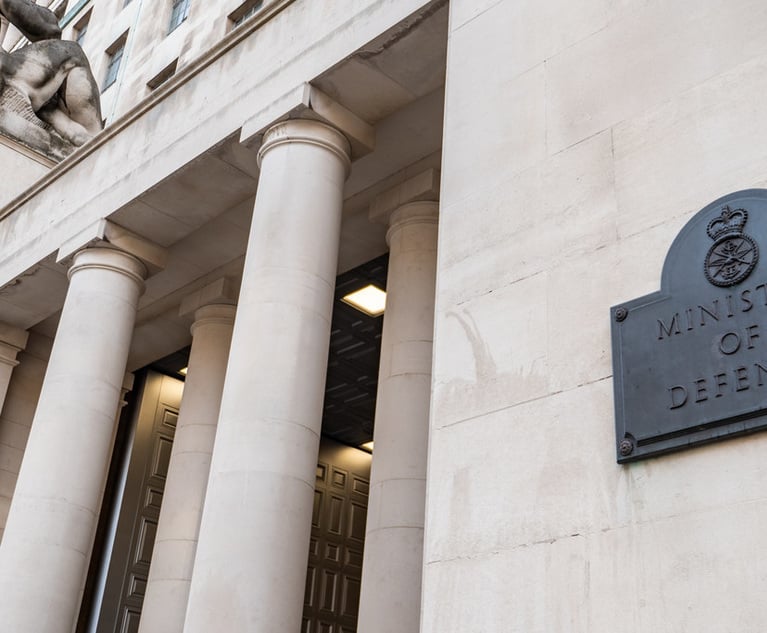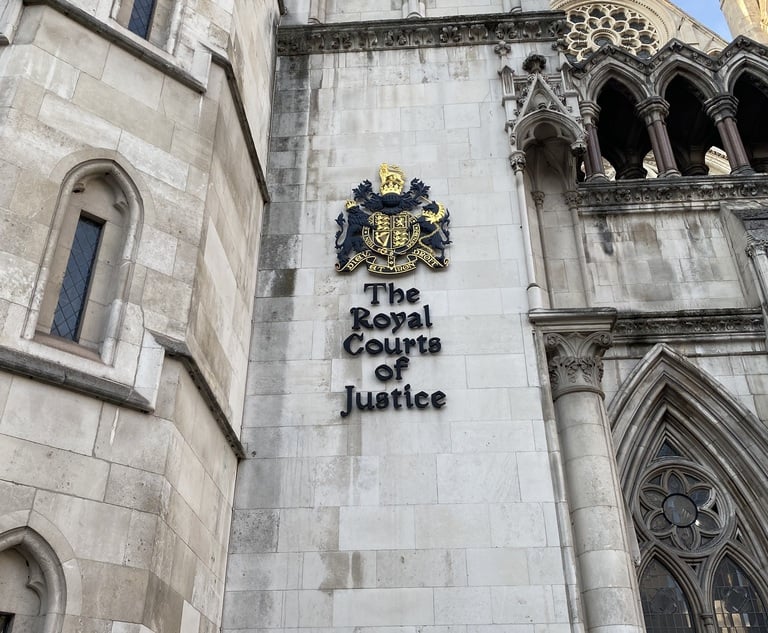Former Halliwells partners win High Court case blocking liquidators from claiming drawings
Nine former Halliwells partners have won a High Court battle to prevent the failed firm's liquidators from claiming alleged overpaid drawings or tax from them.
October 29, 2014 at 01:41 PM
3 minute read
Nine former Halliwells partners have won a High Court battle to prevent the failed firm's liquidators from claiming alleged overpaid drawings or tax from them.
His Honour Judge Hodge QC, sitting as a judge of the High Court, ruled that the liquidators could not pursue claims for overdrawings of £125,000 each, since Steven Fennell, a fixed share partner, and eight others, negotiated a retirement deed before Halliwells' collapse that exempted them from facing claims relating to overdrawn current accounts and tax reserve accounts.
Fennell brought a case against the LLP, which was also used as a test case for the other eight partners.
All nine left the firm shortly before it went into administration in 2010, moving to Kennedys to establish its Sheffield office. They all signed the same
In a ruling from 22 July and published this week, HHJ Hodge said the terms of the deed were "clear" and that it was "inappropriate" for the liquidators to pursue the claim.
He added: "I am satisfied [...] that the terms of the retirement deed are clear. The LLP thereby waived and released any claim to pursue Mr. Fennell (and the other departing fixed share members) for any overpaid drawings and any overpaid tax [...]."
He said that Fennell's decision to leave Halliwells was "motivated by a variety of reasons, although a common factor with those others who left was dissatisfaction at the way in which the LLP was being managed, and what Kennedys had to offer".
The other partners that signed the retirement deed were: Judith Bloor, Cameron Clarke, Niall Edwards, David Fearon, Suzanne Liversidge, Helen Snowball, Heidi Swales and Gregor Woods.
Hodge also refused permission to appeal the decision on the grounds that an appeal would hold "any real prospect of success".
Irwin Mitchell acted for Fennell, instructing Jonathan Adkin QC of Serle Court, while Addleshaw Goddard represented Halliwells and its liquidators, instructing 11 Stone Buildings' Lexa Hilliard QC.
Halliwells went into administration in July 2010, and went into compulsory administration in January 2012.
The ruling also showed that the Royal Bank of Scotland was a secured creditor with debt of £17.7m. It also said that there is an "estimated deficiency as regards of £203m".
Halliwells' principal assets are claims, or possible claims, against former members of the LLP including: claims for overdrawn current accounts and tax reserve accounts against 150 members; claims against 32 former members for recovery of a substantial reverse premium; and possible liquidators' claims against approximately 150 Members under the 1986 Insolvency Act.
Related:
Divided we fall – behind the headlines, the drama and confusion of Halliwells' collapse
This content has been archived. It is available through our partners, LexisNexis® and Bloomberg Law.
To view this content, please continue to their sites.
Not a Lexis Subscriber?
Subscribe Now
Not a Bloomberg Law Subscriber?
Subscribe Now
NOT FOR REPRINT
© 2025 ALM Global, LLC, All Rights Reserved. Request academic re-use from www.copyright.com. All other uses, submit a request to [email protected]. For more information visit Asset & Logo Licensing.
You Might Like
View All
Slaughter and May Leads As Government Buys Back £6 Billion of Military Homes
2 minute read
LatAm Moves: DLA Piper Chile, Brazil’s Demarest Build Out Disputes Muscle

Kingsley Napley and Lord Pannick Spearhead Private Schools' Challenge to Government VAT Policy

Spain Loses Appeal as London Court Rejects Claim of Immunity in €101 Million Arbitral Award Enforcement
Trending Stories
- 1'It's Not Going to Be Pretty': PayPal, Capital One Face Novel Class Actions Over 'Poaching' Commissions Owed Influencers
- 211th Circuit Rejects Trump's Emergency Request as DOJ Prepares to Release Special Counsel's Final Report
- 3Supreme Court Takes Up Challenge to ACA Task Force
- 4'Tragedy of Unspeakable Proportions:' Could Edison, DWP, Face Lawsuits Over LA Wildfires?
- 5Meta Pulls Plug on DEI Programs
Who Got The Work
Michael G. Bongiorno, Andrew Scott Dulberg and Elizabeth E. Driscoll from Wilmer Cutler Pickering Hale and Dorr have stepped in to represent Symbotic Inc., an A.I.-enabled technology platform that focuses on increasing supply chain efficiency, and other defendants in a pending shareholder derivative lawsuit. The case, filed Oct. 2 in Massachusetts District Court by the Brown Law Firm on behalf of Stephen Austen, accuses certain officers and directors of misleading investors in regard to Symbotic's potential for margin growth by failing to disclose that the company was not equipped to timely deploy its systems or manage expenses through project delays. The case, assigned to U.S. District Judge Nathaniel M. Gorton, is 1:24-cv-12522, Austen v. Cohen et al.
Who Got The Work
Edmund Polubinski and Marie Killmond of Davis Polk & Wardwell have entered appearances for data platform software development company MongoDB and other defendants in a pending shareholder derivative lawsuit. The action, filed Oct. 7 in New York Southern District Court by the Brown Law Firm, accuses the company's directors and/or officers of falsely expressing confidence in the company’s restructuring of its sales incentive plan and downplaying the severity of decreases in its upfront commitments. The case is 1:24-cv-07594, Roy v. Ittycheria et al.
Who Got The Work
Amy O. Bruchs and Kurt F. Ellison of Michael Best & Friedrich have entered appearances for Epic Systems Corp. in a pending employment discrimination lawsuit. The suit was filed Sept. 7 in Wisconsin Western District Court by Levine Eisberner LLC and Siri & Glimstad on behalf of a project manager who claims that he was wrongfully terminated after applying for a religious exemption to the defendant's COVID-19 vaccine mandate. The case, assigned to U.S. Magistrate Judge Anita Marie Boor, is 3:24-cv-00630, Secker, Nathan v. Epic Systems Corporation.
Who Got The Work
David X. Sullivan, Thomas J. Finn and Gregory A. Hall from McCarter & English have entered appearances for Sunrun Installation Services in a pending civil rights lawsuit. The complaint was filed Sept. 4 in Connecticut District Court by attorney Robert M. Berke on behalf of former employee George Edward Steins, who was arrested and charged with employing an unregistered home improvement salesperson. The complaint alleges that had Sunrun informed the Connecticut Department of Consumer Protection that the plaintiff's employment had ended in 2017 and that he no longer held Sunrun's home improvement contractor license, he would not have been hit with charges, which were dismissed in May 2024. The case, assigned to U.S. District Judge Jeffrey A. Meyer, is 3:24-cv-01423, Steins v. Sunrun, Inc. et al.
Who Got The Work
Greenberg Traurig shareholder Joshua L. Raskin has entered an appearance for boohoo.com UK Ltd. in a pending patent infringement lawsuit. The suit, filed Sept. 3 in Texas Eastern District Court by Rozier Hardt McDonough on behalf of Alto Dynamics, asserts five patents related to an online shopping platform. The case, assigned to U.S. District Judge Rodney Gilstrap, is 2:24-cv-00719, Alto Dynamics, LLC v. boohoo.com UK Limited.
Featured Firms
Law Offices of Gary Martin Hays & Associates, P.C.
(470) 294-1674
Law Offices of Mark E. Salomone
(857) 444-6468
Smith & Hassler
(713) 739-1250








